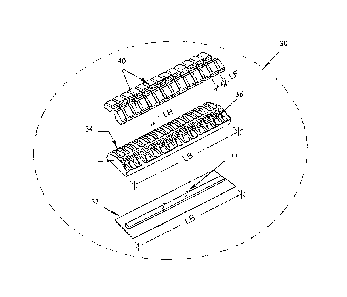Some of the information on this Web page has been provided by external sources. The Government of Canada is not responsible for the accuracy, reliability or currency of the information supplied by external sources. Users wishing to rely upon this information should consult directly with the source of the information. Content provided by external sources is not subject to official languages, privacy and accessibility requirements.
Any discrepancies in the text and image of the Claims and Abstract are due to differing posting times. Text of the Claims and Abstract are posted:
| (12) Patent: | (11) CA 2595002 |
|---|---|
| (54) English Title: | MILL LINER ASSEMBLY |
| (54) French Title: | ASSEMBLAGE DE DOUBLURE DE MOULIN |
| Status: | Granted and Issued |
| (51) International Patent Classification (IPC): |
|
|---|---|
| (72) Inventors : |
|
| (73) Owners : |
|
| (71) Applicants : |
|
| (74) Agent: | MOFFAT & CO. |
| (74) Associate agent: | |
| (45) Issued: | 2014-12-30 |
| (86) PCT Filing Date: | 2006-01-16 |
| (87) Open to Public Inspection: | 2006-07-27 |
| Examination requested: | 2010-11-01 |
| Availability of licence: | N/A |
| Dedicated to the Public: | N/A |
| (25) Language of filing: | English |
| Patent Cooperation Treaty (PCT): | Yes |
|---|---|
| (86) PCT Filing Number: | PCT/AU2006/000049 |
| (87) International Publication Number: | AU2006000049 |
| (85) National Entry: | 2007-07-16 |
| (30) Application Priority Data: | ||||||
|---|---|---|---|---|---|---|
|
A liner assembly for use in a grinding mill, the liner assembly including a
liner body including
a mounting member, and an elastomeric cushioning member operatively connected
to the
mounting member. The cushioning member includes a plurality of support
cavities therein,
and a plurality of wear elements mounted within the support cavities.
Assemblage de doublure pour une utilisation dans un broyeur, l~assemblage de doublure comprenant un corps de doublure comprenant un élément de montage, et un élément amortisseur élastomérique connecté de manière opérationnelle à l~élément de montage. L~élément amortisseur comprend une pluralité de cavités de soutien dans celui-ci et une pluralité d~éléments d~usure montée dans les cavités de soutien.
Note: Claims are shown in the official language in which they were submitted.
Note: Descriptions are shown in the official language in which they were submitted.

2024-08-01:As part of the Next Generation Patents (NGP) transition, the Canadian Patents Database (CPD) now contains a more detailed Event History, which replicates the Event Log of our new back-office solution.
Please note that "Inactive:" events refers to events no longer in use in our new back-office solution.
For a clearer understanding of the status of the application/patent presented on this page, the site Disclaimer , as well as the definitions for Patent , Event History , Maintenance Fee and Payment History should be consulted.
| Description | Date |
|---|---|
| Letter Sent | 2024-01-16 |
| Common Representative Appointed | 2019-10-30 |
| Common Representative Appointed | 2019-10-30 |
| Maintenance Request Received | 2015-01-06 |
| Grant by Issuance | 2014-12-30 |
| Inactive: Cover page published | 2014-12-29 |
| Inactive: Final fee received | 2014-10-14 |
| Pre-grant | 2014-10-14 |
| Correct Applicant Request Received | 2014-10-10 |
| Notice of Allowance is Issued | 2014-04-14 |
| Letter Sent | 2014-04-14 |
| Notice of Allowance is Issued | 2014-04-14 |
| Maintenance Request Received | 2014-01-06 |
| Inactive: Office letter | 2013-02-01 |
| Inactive: Approved for allowance (AFA) | 2013-01-30 |
| Maintenance Request Received | 2013-01-04 |
| Correct Applicant Request Received | 2012-09-04 |
| Amendment Received - Voluntary Amendment | 2012-08-31 |
| Inactive: S.30(2) Rules - Examiner requisition | 2012-03-01 |
| Correct Applicant Request Received | 2011-09-12 |
| Letter Sent | 2010-11-10 |
| Request for Examination Received | 2010-11-01 |
| Request for Examination Requirements Determined Compliant | 2010-11-01 |
| All Requirements for Examination Determined Compliant | 2010-11-01 |
| Letter Sent | 2007-12-04 |
| Inactive: Declaration of entitlement - Formalities | 2007-10-15 |
| Inactive: Single transfer | 2007-10-15 |
| Inactive: Notice - National entry - No RFE | 2007-10-10 |
| Inactive: Cover page published | 2007-10-03 |
| Inactive: Notice - National entry - No RFE | 2007-10-01 |
| Inactive: First IPC assigned | 2007-08-24 |
| Application Received - PCT | 2007-08-23 |
| National Entry Requirements Determined Compliant | 2007-07-16 |
| Application Published (Open to Public Inspection) | 2006-07-27 |
There is no abandonment history.
The last payment was received on 2014-01-06
Note : If the full payment has not been received on or before the date indicated, a further fee may be required which may be one of the following
Patent fees are adjusted on the 1st of January every year. The amounts above are the current amounts if received by December 31 of the current year.
Please refer to the CIPO
Patent Fees
web page to see all current fee amounts.
Note: Records showing the ownership history in alphabetical order.
| Current Owners on Record |
|---|
| VULCO S.A. |
| Past Owners on Record |
|---|
| RICARDO ABARCA MELO |
| RICARDO FERNANDEZ DABERTI |